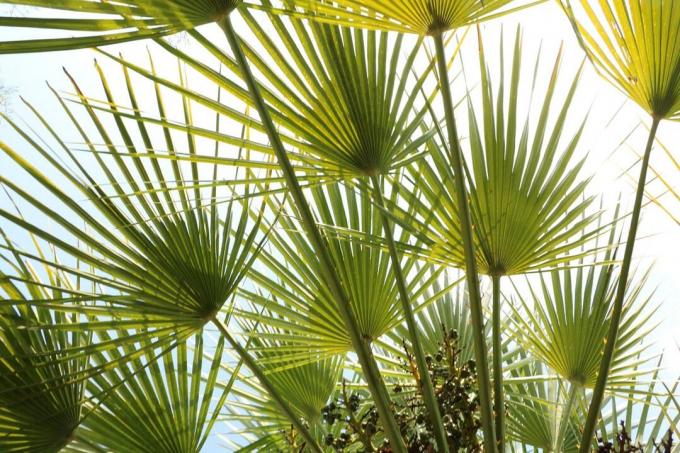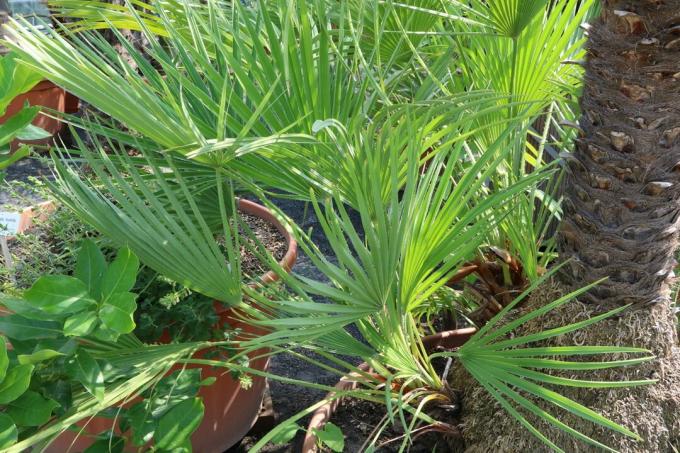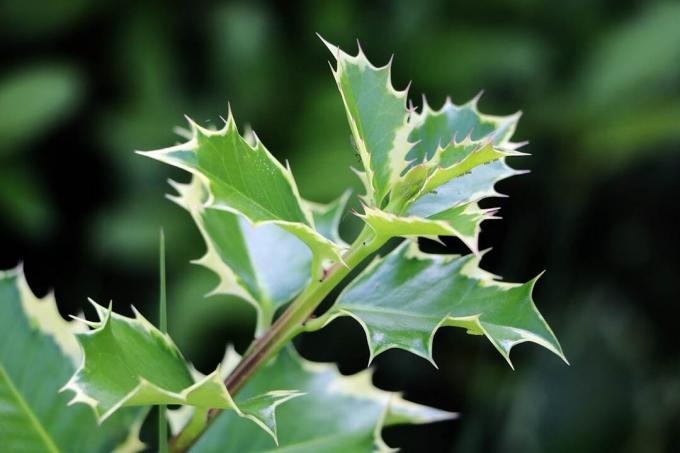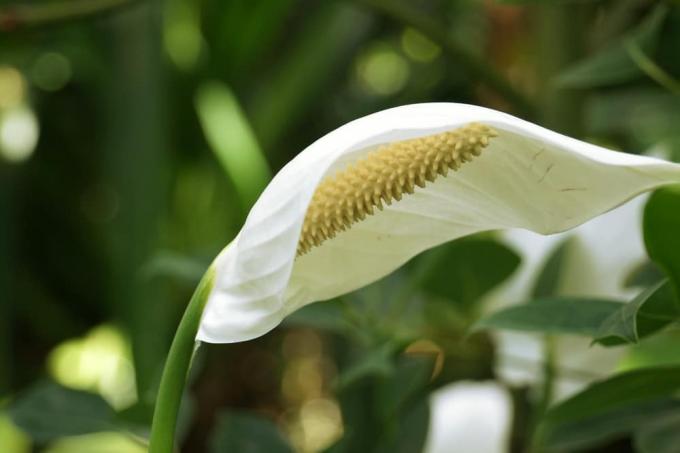

Table of contents
- Characteristics
- Location
- substrate
- plants and repotting
- Pour
- Fertilize
- Cut
- hibernate
- multiply
- diseases and pests
The dwarf palm is well suited as a houseplant that brings some exotic flair into the apartment. Below you will find a care guide that provides everything you need to know about the plant.
Characteristics
- botanical name: Chamaerops humilis
- Origin: Mediterranean
- Plant type: indoor plant, also for terrace or conservatory
- Height: up to 2 m
- Growth: multi-stemmed, dense
- Leaves: green to blue-green fans
- Flower: yellow panicles
- Flowering time: April to June
- Use: good as a single plant in a bright corner of the room
- Hardiness: not hardy
Location
The Chamaerops humilis needs a sunny location, but it also tolerates slightly shady places. In the house, a larger corner of the room between two windows is suitable. A high level of humidity is an advantage; if the air is too dry, the tips of the leaves will dry out.
It is easier to give the plant a place in the garden, on the balcony or the terrace in summer. It's often sunny there. The right location outside should always be sheltered from the wind so that the plant cannot fall over in strong winds.
A notice:
Since the palm tree does grow very large, you should consider that indoors it could quickly get in the way and then be difficult to move.
substrate
In nature, the dwarf palm grows in dry, rocky locations. It therefore prefers sandy to gritty soil as substrate. Normal potting soil should definitely be stretched with sand, expanded clay or gravel. Ideally, it is slightly acidic. An open drainage hole in the pot is also important.

plants and repotting
If you buy a new dwarf palm, you should definitely check whether the pot you bought is big enough for the plant. Many indoor plants grow in pots that are too small and must be repotted immediately after purchase to prevent them from dying. The actual repotting of the dwarf palm is rarely necessary because it only grows slowly. Only every few years does the plant get too big for its pot. The roots then grow out. Instructions for repotting:
- choose a larger pot
- heavy pot gives plant better grip, alternatively fill larger stones in the pot
- Cover the drain hole loosely
- Mix the substrate and fill the pot halfway
- Remove the palm tree from the old pot
- Check roots and prune if necessary
- Put the plant in the new pot
- Fill in the substrate and press down
- water well
Pour
During the growth phase in summer, the palm tree needs water regularly. The soil must not dry out and must be thoroughly moistened with each watering. Nevertheless, under no circumstances should waterlogging occur. This could lead to root rot.
Fertilize
The plant needs a lot of nutrients for healthy growth, especially in summer. A liquid green manure is well suited, which is then simply administered once a week via the irrigation water. In winter it is not necessary to fertilize or if so, then only very rarely, since the palm then hibernates and hardly consumes any nutrients.
Cut
Basically, the Chamaerops humilis does not have to be cut. It grows very compact and dense by nature. However, dried leaf fronds can be removed. This is best done after the winter break. Should there be a severe pest infestation, the corresponding areas can be cut out of the plant.
hibernate
Since the dwarf palm is not hardy, it must inevitably hibernate indoors. It can be outdoors from around May (after the last frosts) to early October.
Tips for wintering:
- be sure to allow before the first frost
- choose a light, airy, cool place in the house
- optimal temperatures between 5 and 10 degrees
- water little, do not fertilize
- regularly check for pests
- clean the plant in spring
- water and fertilize more often
- gradually get used to the outdoors after hibernating
- initially choose a shady spot
A notice:
A palm tree that is only cared for indoors does not necessarily have to move to another location in winter.

multiply
If you want to propagate the dwarf palm, you have the choice between two options, depending on the age of your plant. On the one hand, older palm trees sometimes form daughter plants that are simply separated and planted separately and on the other hand seed heads form after flowering, from which seeds for new plants can be obtained can.
However, propagation via seeds requires a lot of patience, as the plant not only needs a long time to germinate, but also to grow. Quick start Guide:
- Keep seeds dry
- Pour seed compost into a shallow bowl and moisten
- Spread seeds thinly on top
- cover with soil and moisten again
- Cover the bowl loosely with foil
- keep warm and bright but not too sunny
- keep soil moistured
- Germination sometimes takes months, so it is essential to use soil without weed seeds
- separate after germination and plant in their own pots
diseases and pests
Diseases hardly ever occur in the dwarf palm. Pest infestation occurs when the keeping conditions are not quite right. Air that is too dry can lead to spider mite infestation. Frequent spraying with water, on the other hand, helps. Lice can also appear, these can be washed off with a light lye solution and permanently eliminated. Outdoors, Chamaerops humilis is far less susceptible. It is best to take plants outside that are infested with pests; the pest problem then usually resolves itself.
 garden editorial
garden editorial I write about everything that interests me in my garden.
Learn more about Exotic Plants

Holly, holly: care from A to Z
The European holly is one of the evergreen plants. It reaches a height of up to five meters and is ideal as a Christmas decoration or garden shrub. The native, although rarely occurring plant is the only native representative of the Ilex family and is particularly easy to care for and robust.

Dwarf date palm, Phoenix roebelenii: Care from A-Z
The dwarf date palm (Phoenix roebelenii) is a particularly small, actually the smallest palm species of its genus. But that doesn't make them any less decorative. It is the most filigree and elegant date palm and hardly grows higher than one meter.

Growing vanilla plants: 11 tips for care
The vanilla plant is truly exotic in Central Europe and cannot be found in every garden. Vanilla planifolia forms the aromatic pods for which the plant is known. The cultivation of a vanilla plant is easily possible with the right care tips.

Kangaroo Paw: Caring for the kangaroo plant
Kangaroo paws are exotic plants native to southwestern Australia. Considering the care instructions, Kangaroo Paw can also thrive in Central European conditions. Maintenance requires a little more effort. If the plant gets enough attention, it will thank you with magnificent inflorescences.

Einblatt, Spathiphyllum: care from A to Z
Because of simple! The single sheet draws everyone's attention with its extravagant appearance. The imposing flower gives sophisticated rooms that certain something. If the houseplant is in the right place, hardly any care is required. The breeder can find out here what demands Spathiphyllum places on their location.

9 psychoactive & hallucinogenic plants in the garden
Even in this country psychoactive and hallucinogenic plants grow, many of them even in the local gardens. However, the herbal ingredients of domestic natural drugs are often characterized by a high toxic potential. Therefore, severe poisoning often occurs after consumption.

